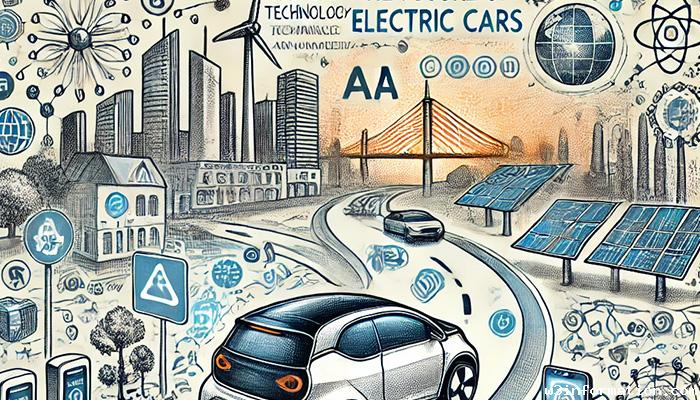The Future of Electric Cars: Trends and Innovations
Electric cars (EVs) have quickly evolved from specialty innovations into common vehicle options. The automotive industry's transformation through environmental concerns and technological advancements along with increasing fuel costs enhances the potential for electric vehicles to become dominant in transportation solutions. Investments in sustainable transport and new battery technologies will transform the way we drive and city planning. Our blog post examines essential trends and breakthroughs that will define electric cars' future.
- The Rise of Battery Technology: Longer Range and Faster Charging
- Affordability: Making Electric Cars Accessible to All
- Autonomous Driving: Integrating Electric Cars with Self-Driving Technology
- Sustainability and Green Manufacturing
- Smart Features and Connectivity: A New Era of In-Car Technology
- The Global Shift Towards Electrification
- The Future of EV Design: Sleeker, Smarter, and More Sustainable
- More Related Topics
The Rise of Battery Technology: Longer Range and Faster Charging
The primary obstacle for electric vehicles has remained their battery endurance and charging duration. Battery technology advancements are occurring rapidly with significant improvements being made to both vehicle range and charging time.
a. Solid-State Batteries
Solid-state batteries hold promise to revolutionize electric vehicle technology. Solid-state batteries differ from traditional lithium-ion batteries because they incorporate a solid electrolyte rather than a liquid one which results in better energy density, quicker charging times and improved safety. Electric vehicles benefit from these batteries because they are lighter and more efficient while also reducing overheating risks. Toyota and BMW along with other major automakers are actively funding solid-state battery research which promises commercial availability in the near future.
b. Faster Charging Solutions
Charging infrastructure is evolving quickly as well. Tesla set the standard by developing their Supercharger network while other companies continue to increase the charging speeds to compete. Automotive charging stations are now available that can power up a vehicle battery to 80% charge in fifteen minutes or less. The swift progress in charging station technology alongside extensive public charging network deployments will transform long-distance EV travel into a more practical choice than it has ever been.

Affordability: Making Electric Cars Accessible to All
The significant expense of electric vehicles has been one of the main obstacles to their widespread adoption. The landscape of electric vehicle affordability continues to evolve because battery prices keep falling while economies of scale enhance production efficiency.
a. Economies of Scale and Lower Production Costs
Electric car manufacturers are expanding their production capacities to meet worldwide demand which results in reduced costs for each vehicle produced. Automakers can transfer cost savings to customers through enhanced manufacturing processes and production line automation. The reduction in electric car costs and increased production will expand market reach by allowing more buyers to afford these vehicles.
b. Government Incentives and Subsidies
Worldwide governments have implemented significant incentives to encourage consumer adoption of electric vehicles. The upfront purchase price of electric vehicles is reduced through tax credits and other forms of government support. The U.S. federal government provides EV buyers with tax credits up to $7,500 and many states also provide extra rebates. The commitment of additional countries to eliminate internal combustion engine vehicles will probably lead to greater incentives which will speed up the adoption of electric mobility.
Autonomous Driving: Integrating Electric Cars with Self-Driving Technology
The electric vehicle revolution encompasses both electrification and the development of automated driving systems. Electric vehicles are perfectly positioned to benefit from autonomous driving technology because they have simpler mechanical systems and operate primarily through electronic components.
a. Electric and Autonomous Vehicle Integration
Technological pioneers such as Tesla and Waymo are merging electric vehicle technology with self-driving systems to develop autonomous electric cars. The reduced mechanical complexity of electric cars compared to traditional vehicles enables them to serve as superior platforms for implementing self-driving technology. Self-driving electric vehicles enhance travel convenience by operating independently from human drivers thus eliminating the need for manual vehicle control.
b. Safety and Efficiency Enhancements
Self-driving vehicles can enhance safety standards because human mistakes account for most traffic accidents. Electric drivetrains in self-driving vehicles can achieve energy optimization through autonomous systems which provide seamless acceleration and braking together with efficient route planning. The implementation of these strategies will help lower carbon emissions and extend electric vehicle range through more efficient energy usage.
Sustainability and Green Manufacturing
Electric vehicles deliver clear environmental advantages yet their ability to support sustainable development depends on their production methods and the origin of their charging energy.
a. Sustainable Manufacturing Practices
Automakers have started to prioritize production sustainability as demand for electric vehicles increases. Automakers such as BMW, Tesla, and Volkswagen have implemented sustainable manufacturing practices by incorporating recycled materials into their car components and engineering vehicles to prioritize recyclability. Some automobile companies are putting money into green factories powered by renewable energy which helps to cut down electric vehicles' carbon emissions.
b. Green Energy Integration
Electric vehicles deliver greater environmental benefits when their charging power originates from renewable sources such as solar or wind energy. Energy providers alongside electric vehicle manufacturers explore options to combine EV charging infrastructure with sustainable energy sources. Homeowners can produce their electricity and power their EVs through Tesla’s solar roof and Powerwall systems which utilize solar energy. Smart grids combined with vehicle-to-grid (V2G) technologies will empower electric vehicles (EVs) to contribute to the grid by storing surplus energy and releasing it back into the network thus enhancing system sustainability.
Smart Features and Connectivity: A New Era of In-Car Technology
Electric cars now transform into sophisticated vehicles that deliver both advanced in-car systems and smart functionality.
a. Infotainment Systems
Electric vehicles now commonly feature advanced infotainment systems which enable drivers to manage navigation, music playback, climate settings and car diagnostics using a unified touchscreen interface. Tesla along with Rivian and Lucid Motors are advancing automotive technology through their implementation of extensive high-resolution touchscreens which function as the chief control interface for almost all vehicle operations.
b. Over-the-Air (OTA) Updates
Numerous electric vehicles feature remote software update capabilities through over-the-air (OTA) technology. Manufacturers can enhance your vehicle's performance and introduce new features without needing you to visit the dealership. Tesla regularly deploys updates to extend its vehicles’ driving range and safety performance while introducing new features for drivers.
c. Vehicle-to-Everything (V2X) Communication
Through Vehicle-to-Everything (V2X) technology electric vehicles will interact with their environment in the future. V2X technology enables cars to exchange information with other vehicles as well as traffic lights, road infrastructure systems and pedestrians. This technology will help increase traffic safety and reduce congestion while boosting energy efficiency through optimized traffic flow and real-time route planning capabilities.
The Global Shift Towards Electrification
National governments around the world establish forward-thinking goals for electric vehicle development and create supportive frameworks to drive their expansion and adoption.
a. Phasing Out Gasoline and Diesel Vehicles
The UK together with France and Norway among other European nations declared plans to eliminate gasoline and diesel vehicles by 2030 or 2035. Both China and India have established strong objectives to increase electric vehicle adoption rates. Environmental worries about air quality and carbon emissions alongside the need to minimize fossil fuel reliance propel the worldwide movement towards electrification.
b. Charging Infrastructure Expansion
The rising number of electric vehicles has led to substantial investments from governments and private entities focused on expanding the charging infrastructure. EV owners now have convenient access to charging points because fast-charging stations have been installed across highways and urban areas as well as at workplaces. Fast charging networks must be widespread to enable electric vehicles to become an accessible choice for everyday drivers.
The Future of EV Design: Sleeker, Smarter, and More Sustainable
Automakers are expanding design parameters to enhance EV appeal and functionality as electric vehicle demand grows.
a. Aerodynamic and Lightweight Designs
Electric vehicle design will keep focusing on enhancing aerodynamics and lowering vehicle weight. By reducing drag through sleeker designs vehicles achieve better range while manufacturers use lightweight materials like carbon fiber and aluminum to boost energy efficiency. The industry advancements will produce electric vehicles that combine attractive design with improved fuel efficiency.
b. Modular and Customizable Interiors
Designers benefit from the absence of traditional engines because they can create spacious interiors with innovative and customizable features. Future vehicle designs will incorporate flexible layouts with modular elements such as adjustable seating and configurable storage to improve both comfort and functionality.
Conclusion: A Greener, Smarter Future for Electric Cars
Electric vehicles show a bright future because of fast-progressing battery technology alongside autonomous driving systems and sustainable production methods. Electric vehicles are expected to become the primary transportation choice as they continue to decrease in price while improving efficiency and smart technology integration. The collaboration between governments and automakers along with consumer participation speeds up electric mobility adoption while improved infrastructure makes electric cars increasingly practical for sustainable transportation. Electric car adoption represents a path toward cleaner transportation which also leads to a more sustainable and innovative world for everyone.
 Top 10 Comfort Foods to Try This Winter
Top 10 Comfort Foods to Try This Winter
 Top 10 Christmas Destinations Around the World
Top 10 Christmas Destinations Around the World
 Navigating Adolescence: Tips for Parents and Teens
Navigating Adolescence: Tips for Parents and Teens
 How to Start a DIY Craft Project on a Budget
How to Start a DIY Craft Project on a Budget
 How to Build Strong Family Bonds in the Digital Age
How to Build Strong Family Bonds in the Digital Age
 The Importance of Early Childhood Education
The Importance of Early Childhood Education